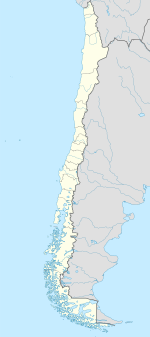
La Serena is a city and commune in northern Chile, capital of the Coquimbo Region. Founded in 1544, it is the country's second oldest city after the national capital, Santiago. As of 2012, it had a communal population of roughly 200,000, and was one of the fastest-growing areas of Chile.

Ovalle is a city in the Coquimbo Region of Chile, founded in 1831 as a settlement. It has a population of more than 113,000 people. The name Ovalle was chosen to honor to Chile's vice-president, José Tomás Ovalle. Ovalle is the capital of the Limarí Province.
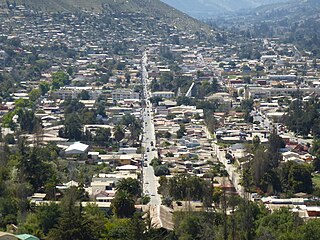
Illapel is a Chilean city, which is the capital of the Choapa Province, Coquimbo Region. It lies along the Illapel River and marks the country's narrowest point along a parallel (94 km). It is located to the east of Los Vilos.

Vicuña is a Chilean commune and city in Elqui Province, Coquimbo Region, founded during the government of Bernardo O'Higgins to secure sovereignty over the Elqui Valley. Poet Gabriela Mistral was born there in 1889. It shares borders to the west with the communes of La Higuera, La Serena and Andacollo, to the east with Argentina and to the south with Paihuano and Rio Hurtado. The commune is administered by the municipality of Vicuña, which is the principal city of the Valle de Elqui.

Coquimbo is a port city, commune and capital of the Elqui Province, located on the Pan-American Highway, in the Coquimbo Region of Chile. Coquimbo is situated in a valley 10 km (6 mi) south of La Serena, with which it forms Greater La Serena with more than 400,000 inhabitants. The commune spans an area around the harbor of 1,429.3 km2 (552 sq mi). The average temperature in the city lies around 14 °C (57 °F), and precipitation is low.

DalcahueSpanish pronunciation: [dalˈkawe] is a port city and a commune on Chiloé Island, Los Lagos Region, Chile.

Combarbalá is the capital city of the commune of Combarbala. It is located in the Limarí Province, Region of Coquimbo, at an elevation of 900 m (2,952 ft). It is known for the tourist astronomic observatory Cruz del Sur; the petroglyphs of Rincon las Chilcas; its typical handcraft made of the unique combarbalita stone; the classical basketball match at the end February; the Virgen de la Piedra catholic-pagan festivity, among other tourist attractions.
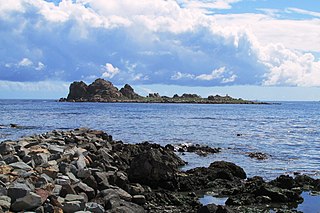
Los Vilos? is both a Chilean coastal commune and a coastal city with over 9,000 inhabitants, located in the Province of Choapa, part of the IV Region of Coquimbo. The city has a harbour called Puerto Punta Chungo, that ships the material of Los Pelambres mine. Fishing is one of its main activities. The city also has a significant amount of tourism, mainly due to its two beaches: La Principal and Las Conchas. It is located at 246 kilometres (153 mi) from La Serena and 246 kilometres (153 mi) from Santiago.

Elqui Province is a province in the Chilean region of Coquimbo (IV). The provincial capital is the city of Coquimbo.

Salamanca is a Chilean city and commune in Choapa Province, Coquimbo Region. It is located 30 km (19 mi) east of Illapel, the province's administrative center, and 316 km (196 mi) north of Santiago, Chile. It is normally accessed from Los Vilos, which lies next to the Panamerican Highway, and connects the city to the rest of the country.

Limache is a Chilean town and township in the Marga Marga Province, Valparaíso Region. Limache is the only township of Chile that has two urban areas: San Francisco de Limache on the north side of the Pelumpén stream, and Limache Viejo on the south side. Limache is famous for its tomato production and the religious feast of "The Virgin of the 40 Hours".
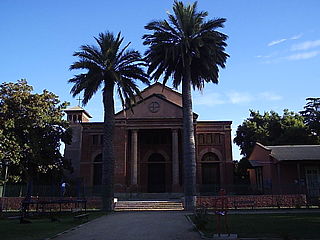
Nancagua is a Chilean city and commune in Colchagua Province, O'Higgins Region.
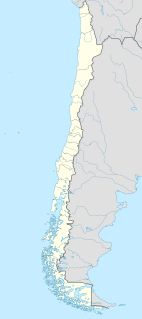
Tucapel is a town and commune in the Arauco Province, Bío Bío Region, Chile. It was once a region of Araucanía named for the Tucapel River. The name of the region derived from the rehue and aillarehue of the Moluche people of the area between the Lebu and the Lleulleu Rivers, who were famed for their long resistance to the Spanish in the Arauco War. Tucapel is also the name of a famous leader from that region in the first resistance against the Spanish mentioned in Alonso de Ercilla's epic poem La Araucana. Formerly belonging to the Nuble Province, in the Department of Yungay. Near the town of Tucapel is the Plaza de San Diego de Tucapel. The capital of the commune is the town of Huépil, moving the municipality from Tucapel in 1967. In mapudungún its name means "To seize or to take by force".

Paiguano or Paihuano is a small agricultural town and commune in the Elqui Province of the Coquimbo Region of Chile.

Taltal is a Chilean commune and city in Antofagasta Province, Antofagasta Region. According to the 2012 census, the commune has a population of 11,132 and has an area of 20,405.1 km2 (7,878 sq mi). The commune is home to Paranal Observatory and includes the northern portion of Pan de Azúcar National Park.

Laja is a city and commune located in the Bío Bío Province of the Bío Bío Region of Chile. The city of Laja is the communal capital.

La Higuera is a town and commune in Elqui Province, Coquimbo Region, Chile. It is bordered on the west by the Pacific Ocean, the east by the Atacama Region, and the south by the communes of Vicuña and La Serena.

Río Hurtado is one of five communes in the Limarí Province of Chile's north-central IV Coquimbo Region.

Isla de Maipo is a town and commune of the Talagante Province in central Chile's Santiago Metropolitan Region.
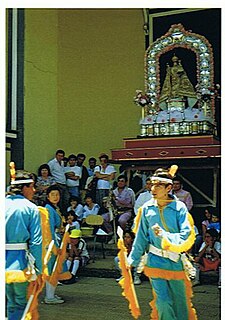
Our Lady of Andacollo, also known as the Virgin of Andacollo, is a celebrated Catholic statue of the Virgin Mary located in the town of Andacollo, in the Coquimbo Region in the north of Chile. The carving is the centre of the annual Fiesta Grande de la Virgen that draws thousands of pilgrims from around the world in December.



